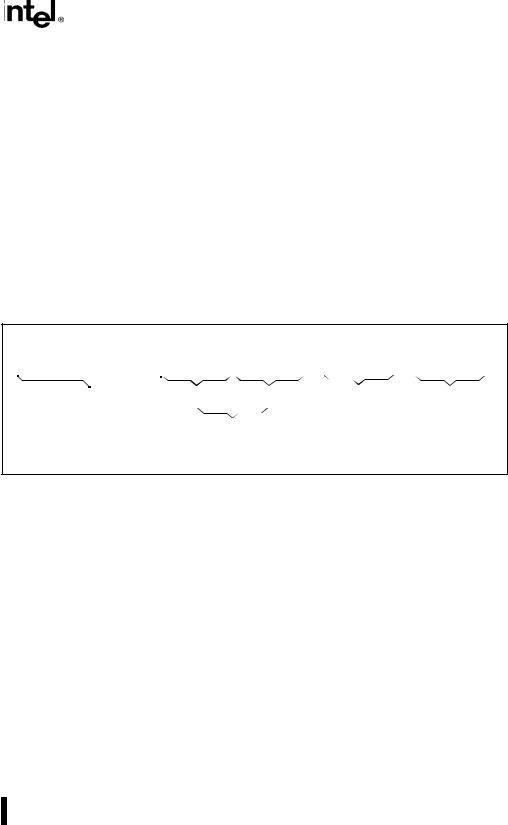
- •1.4. NOTATIONAL CONVENTIONS
- •1.4.1. Bit and Byte Order
- •1.4.2. Reserved Bits and Software Compatibility
- •1.4.3. Instruction Operands
- •1.4.4. Hexadecimal and Binary Numbers
- •1.4.5. Segmented Addressing
- •1.4.6. Exceptions
- •1.5. RELATED LITERATURE
- •2.1. GENERAL INSTRUCTION FORMAT
- •2.2. INSTRUCTION PREFIXES
- •2.3. OPCODE
- •2.4. MODR/M AND SIB BYTES
- •2.5. DISPLACEMENT AND IMMEDIATE BYTES
- •3.1. INTERPRETING THE INSTRUCTION REFERENCE PAGES
- •3.1.1. Instruction Format
- •3.1.1.1. OPCODE COLUMN
- •3.1.1.2. INSTRUCTION COLUMN
- •3.1.1.3. DESCRIPTION COLUMN
- •3.1.1.4. DESCRIPTION
- •3.1.2. Operation
- •3.1.3. Flags Affected
- •3.1.4. FPU Flags Affected
- •3.1.5. Protected Mode Exceptions
- •3.2. INSTRUCTION REFERENCE
- •A.1. KEY TO ABBREVIATIONS
- •A.1.1. Codes for Addressing Method
- •A.1.2. Codes for Operand Type
- •A.1.3. Register Codes
- •A.2. ONE-BYTE OPCODE INTEGER INSTRUCTIONS
- •A.3. TWO-BYTE OPCODE INTEGER INSTRUCTIONS
- •A.5. ESCAPE OPCODE INSTRUCTIONS
- •A.5.1. Escape Opcodes with D8 as First Byte
- •A.5.2. Escape Opcodes with D9 as First Byte
- •A.5.3. Escape Opcodes with DA as First Byte
- •A.5.4. Escape Opcodes with DB as First Byte
- •A.5.5. Escape Opcodes with DC as First Byte
- •A.5.6. Escape Opcodes with DD as First Byte
- •A.5.7. Escape Opcodes with DE as First Byte
- •A.5.8. Escape Opcodes with DF As First Byte
- •B.1. MACHINE INSTRUCTION FORMAT
- •B.1.1. Reg Field (reg)
- •B.1.2. Encoding of Operand Size Bit (w)
- •B.1.3. Sign Extend (s) Bit
- •B.1.4. Segment Register Field (sreg)
- •B.1.5. Special-Purpose Register (eee) Field
- •B.1.6. Condition Test Field (tttn)
- •B.1.7. Direction (d) Bit
- •B.2. INTEGER INSTRUCTION FORMATS AND ENCODINGS
- •B.3. MMX™ INSTRUCTION FORMATS AND ENCODINGS
- •B.3.1. Granularity Field (gg)
- •B.3.3. MMX™ Instruction Formats and Encodings Table
- •B.4. FLOATING-POINT INSTRUCTION FORMATS AND ENCODINGS
- •INDEX

APPENDIX B INSTRUCTION FORMATS AND ENCODINGS
This appendix shows the formats and encodings of the Intel Architecture instructions. The main format and encoding tables are Tables B-10, B-14, and B-16.
B.1. MACHINE INSTRUCTION FORMAT
All Intel Architecture instructions are encoded using subsets of the general machine instruction format shown in Figure B-1. Each instruction consists of an opcode, a register and/or address mode specifier (if required) consisting of the ModR/M byte and sometimes the scale-index-base (SIB) byte, a displacement (if required), and an immediate data field (if required).
7 6 5 4 3 2 1 0 7 6 5 4 3 2 1 0 7-6 5-3 2-0 7-6 5-3 2-0 |
|
|
|||
T T T T T T T T |
T T T T T T T T |
Mod Reg* R/M |
Scale Index Base |
d32 | 16 | 8 | None |
d32 | 16 | 8 | None |
|
|
|
|
Address Displacement |
Immediate Data |
Opcode |
ModR/M Byte |
SIB Byte |
|||
1 or 2 Bytes |
|
|
(4, 2, 1 Bytes or None) (4,2,1 Bytes or None) |
||
(T Represents an |
Register and/or Address |
|
|
||
|
|
|
|
||
Opcode Bit) |
Mode Specifier |
|
*Reg Field is sometimes used as an opcode extension field (TTT).
Figure B-1. General Machine Instruction Format
The primary opcode for an instruction is encoded in one or two bytes of the instruction. Some instructions also use an opcode extension field encoded in bits 5, 4, and 3 of the ModR/M byte. Within the primary opcode, smaller encoding fields may be defined. These fields vary according to the class of operation being performed. The fields define such information as register encoding, conditional test performed, or sign extension of immediate byte.
Almost all instructions that refer to a register and/or memory operand have a register and/or address mode byte following the opcode. This byte, the ModR/M byte, consists of the mod field, the reg field, and the R/M field. Certain encodings of the ModR/M byte indicate that a second address mode byte, the SIB byte, must be used.
If the selected addressing mode specifies a displacement, the displacement value is placed immediately following the ModR/M byte or SIB byte. If a displacement is present, the possible sizes are 8, 16, or 32 bits.
If the instruction specifies an immediate operand, the immediate value follows any displacement bytes. An immediate operand, if specified, is always the last field of the instruction.
B-1

INSTRUCTION FORMATS AND ENCODINGS
Table B-1 lists several smaller fields or bits that appear in certain instructions, sometimes within the opcode bytes themselves. The following tables describe these fields and bits and list the allowable values. All of these fields (except the d bit) are shown in the integer instruction formats given in Table B-10.
Table B-1. Special Fields Within Instruction Encodings
Field Name |
Description |
Number of |
|
|
Bits |
|
|
|
reg |
General-register specifier (see Table B-2 or B-3) |
3 |
|
|
|
w |
Specifies if data is byte or full-sized, where full-sized is either 16 or 32 |
1 |
|
bits (see Table B-4) |
|
|
|
|
s |
Specifies sign extension of an immediate data field (see Table B-5) |
1 |
|
|
|
sreg2 |
Segment register specifier for CS, SS, DS, ES (see Table B-6) |
2 |
|
|
|
sreg3 |
Segment register specifier for CS, SS, DS, ES, FS, GS (see Table B-6) |
3 |
|
|
|
eee |
Specifies a special-purpose (control or debug) register (see |
3 |
|
Table B-7) |
|
|
|
|
tttn |
For conditional instructions, specifies a condition asserted or a |
4 |
|
condition negated (see Table B-8) |
|
|
|
|
d |
Specifies direction of data operation (see Table B-9) |
1 |
|
|
|
B.1.1. Reg Field (reg)
The reg field in the ModR/M byte specifies a general-purpose register operand. The group of registers specified is modified by the presence of and state of the w bit in an encoding (see Table B-4). Table B-2 shows the encoding of the reg field when the w bit is not present in an encoding, and Table B-3 shows the encoding of the reg field when the w bit is present.
Table B-2. Encoding of reg Field When w Field is Not Present in Instruction
|
Register Selected during |
Register Selected during |
reg Field |
16-Bit Data Operations |
32-Bit Data Operations |
|
|
|
000 |
AX |
EAX |
001 |
CX |
ECX |
010 |
DX |
EDX |
011 |
BX |
EBX |
100 |
SP |
ESP |
101 |
BP |
EBP |
110 |
SI |
ESI |
111 |
DI |
EDI |
|
|
|
B-2

INSTRUCTION FORMATS AND ENCODINGS
Table B-3. Encoding of reg Field When w Field is Present in Instruction
Register Specified by reg Field during 16-Bit Data Operations
|
Function of w Field |
|
|
|
|
reg |
When w = 0 |
When w = 1 |
|
|
|
000 |
AL |
AX |
001 |
CL |
CX |
010 |
DL |
DX |
011 |
BL |
BX |
100 |
AH |
SP |
101 |
CH |
BP |
110 |
DH |
SI |
111 |
BH |
DI |
|
|
|
Register Specified by reg Field during 32-Bit Data Operations
|
Function of w Field |
|
|
|
|
reg |
When w = 0 |
When w = 1 |
|
|
|
000 |
AL |
EAX |
001 |
CL |
ECX |
010 |
DL |
EDX |
011 |
BL |
EBX |
100 |
AH |
ESP |
101 |
CH |
EBP |
110 |
DH |
ESI |
111 |
BH |
EDI |
|
|
|
B.1.2. Encoding of Operand Size Bit (w)
The current operand-size attribute determines whether the processor is performing 16-or 32-bit operations. Within the constraints of the current operand-size attribute, the operand-size bit (w) can be used to indicate operations on 8-bit operands or the full operand size specified with the operand-size attribute (16 bits or 32 bits). Table B-4 shows the encoding of the w bit depending on the current operand-size attribute.
Table B-4. Encoding of Operand Size (w) Bit
|
Operand Size When |
Operand Size When |
w Bit |
Operand-Size Attribute is 16 bits |
Operand-Size Attribute is 32 bits |
|
|
|
0 |
8 Bits |
8 Bits |
1 |
16 Bits |
32 Bits |
|
|
|
B.1.3. Sign Extend (s) Bit
The sign-extend (s) bit occurs primarily in instructions with immediate data fields that are being extended from 8 bits to 16 or 32 bits. Table B-5 shows the encoding of the s bit.
Table B-5. Encoding of Sign-Extend (s) Bit
|
Effect on 8-Bit |
Effect on 16or 32-Bit |
s |
Immediate Data |
Immediate Data |
|
|
|
0 |
None |
None |
1 |
Sign-extend to fill 16-bit or 32-bit destination |
None |
|
|
|
B-3

INSTRUCTION FORMATS AND ENCODINGS
B.1.4. Segment Register Field (sreg)
When an instruction operates on a segment register, the reg field in the ModR/M byte is called the sreg field and is used to specify the segment register. Table B-6 shows the encoding of the sreg field. This field is sometimes a 2-bit field (sreg2) and other times a 3-bit field (sreg3).
Table B-6. Encoding of the Segment Register (sreg) Field
|
Segment Register |
2-Bit sreg2 Field |
Selected |
|
|
00 |
ES |
01 |
CS |
10 |
SS |
11 |
DS |
|
|
* Do not use reserved encodings.
|
Segment Register |
3-Bit sreg3 Field |
Selected |
|
|
000 |
ES |
001 |
CS |
010 |
SS |
011 |
DS |
100 |
FS |
101 |
GS |
110 |
Reserved* |
111 |
Reserved* |
|
|
B.1.5. Special-Purpose Register (eee) Field
When the control or debug registers are referenced in an instruction they are encoded in the eee field, which is located in bits 5, 4, and 3 of the ModR/M byte. Table B-7 shows the encoding of the eee field.
Table B-7. Encoding of Special-Purpose Register (eee) Field
eee |
Control Register |
Debug Register |
|
|
|
000 |
CR0 |
DR0 |
001 |
Reserved* |
DR1 |
010 |
CR2 |
DR2 |
011 |
CR3 |
DR3 |
100 |
CR4 |
Reserved* |
101 |
Reserved* |
Reserved* |
110 |
Reserved* |
DR6 |
111 |
Reserved* |
DR7 |
|
|
|
* Do not use reserved encodings.
B-4
